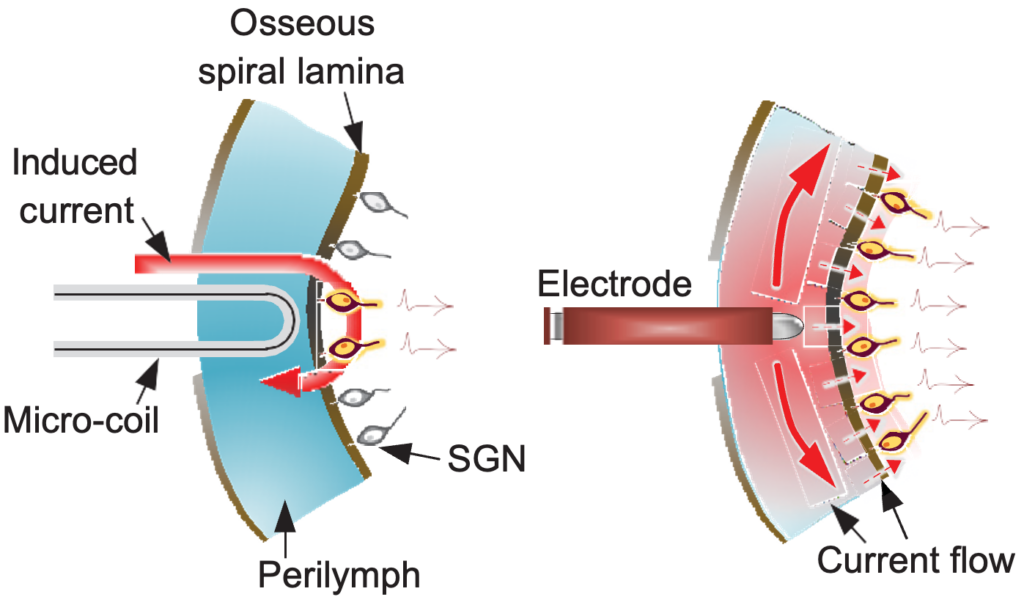Cochlear implants (CIs) enable the profoundly deaf to hear and understand speech in quiet environments. However, they become much less effective when background noise levels are high; they also do not enable music to be appreciated. This suboptimal component of their performance is thought to arise because the spatially/spectrally broad activation of the cochlea arising from electric stimulation leads to unwanted channel interactions that degrade the quality of the information transmitted to the brain. Recently, we’ve shown that magnetic stimulation from micro-coils provides narrower activation of the cochlea, thereby better approximating the signaling patterns that arise naturally, and suggesting that coil-based devices may have the potential to significantly improve CI performance. Current efforts are focused on the design, development, and testing of micro-coils as a next-generation C
Background
The implantation of micro-electrode arrays into the cochlea (referred to as cochlear implants, CIs) allows the profoundly deaf to understand speech in a quiet environment. While this is a remarkable advance that has helped tens of thousands of users, performance is significantly reduced when background noise levels are higher. In addition, most CI users cannot appreciate music. While multiple factors are likely to contribute, electric stimulation is known to produce spectrally broad activation of the cochlea, resulting in overlap between neighboring channels and thus reducing the number of independent spectral channels (speech discrimination in high background noise levels and music appreciation are both thought to require a larger number of independent spectral channels than can be generated by existing implants). Increasing the number of channels has proven challenging however, as the highly conductive solution surrounding implants (perilymph) expands the spread of activation from each electrode so that fields from neighboring electrodes overlap and channels are no longer independent. The spread of fields is worsened because the targets of stimulation (spiral ganglion neurons) are situated across a bony wall from the implant and thus higher stimulus levels are required for activation which lead to increased current spread.
Microcoils may be an attractive alternative to electrodes because the physics governing the spread of induced fields (Maxwell’s equations) suggests narrower confinement of activation. Further, the high permeability of biological tissues to magnetic fields allows stimulation to pass readily through the bony wall, without the need for increased stimulation levels (and the resulting spread of activation). Consistent with this, stimulation from micro-coils implanted in the cochleae of both mice (Lee et al., 2022) and guinea pig (study in progress) results in narrow channels of activation in the inferior colliculus, i.e., better approximating the normal physiological signal, and smaller than those from electrodes. The ability to create narrow spectral channels suggests a larger number of independent channels are possible with microcoils and thus the potential exists for improved rehabilitation of hearing.
What We Do
Our goal is to further develop microcoils for use in CIs. Efforts include (1) the use of electromagnetic theory and computational modeling to optimize the design of coils for use in CIs, (2) development of promising designs including fabrication of both single coils as well as arrays, (3) physiological experiments to evaluate performance of implanted microcoils, and (4) chronic implantation studies to assess device stability over time.
Selected Publications
Lee, J.I., Seist, R., McInturff, S., Lee, D.J., Brown, M.C., Stankovic, K.M., Fried, S.I. 2022. Magnetic stimulation allows focal activation of the mouse cochlea. eLife 11:e76682. PMID: 35608242

